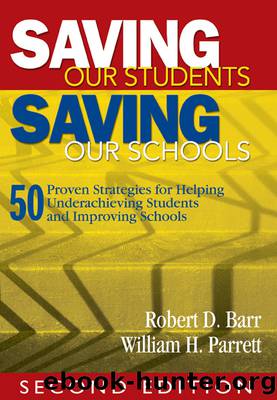Saving Our Students, Saving Our Schools by Barr Robert Dale;Parrett William H.;

Author:Barr, Robert Dale;Parrett, William H.; [Barr, Robert D.]
Language: eng
Format: epub
ISBN: 1994146
Publisher: Corwin Press
Published: 2007-10-08T00:00:00+00:00
See the â50 Strategies Suggested Readingâ section for a list of resources selected to complement the fifty strategies as you put them to use in your classroom.
STRATEGY #30
Help At-Risk Students Pass High-Stakes Tests
My school assigned me to the lowest-performing students in the school, and I have a policy with the kids: We can never say, âI canât do this.â We are always positive. I spend more time than a football coach trying to build self-confidence. We also work hard to prepare for the state tests. We develop rhymes, we sing songs, we chant together, we take simulated tests, and guess what? It all worked. Every one of my children passed the test!
âTeacher, Texas
With few exceptions, conversations with teachers, administrators, and parents everywhere in the United States tend to focus on the great challenge of helping at-risk students learn effectively, improve academic performance, and successfully pass the high-stakes achievement tests necessary in most states for grade promotion and graduation. Many of these students arrive at school from lives of poverty or limited-English-speaking backgrounds. Without significant intervention, most of these students fall behind; many are retained; and far too many ultimately drop out of school. These students are also traditionally poor test takers. As a result, schools face a dual and daunting challenge. Not only must they ensure that the students learn effectively, they must also help these students become effective test takers. Unfortunately, state-mandated tests often present students with a cultural bias, and, for many students, the tests are offered in a language in which the student may be less than fluent or confident.
The use of a single, standardized test for retention or promotion has been seriously criticized and has yet to be shown to be an effective incentive for learning; at its worst, the tests increase dropout rates, particularly for poor and minority students. High-stakes testing has also led to a growing number of teacher, parent, and student boycotts throughout the country, along with other types of civil disobedience. Yet, for good or bad, it appears that high-stakes tests are here to stay and that most families, educators, and students seem to be accepting them as a new way of life in school. Recent polls by Public Agenda (2002), a nonprofit polling organization, found that the great majority of middle and high school students are comfortable with increased testing in public schools. Eight out of ten students surveyed believed that standardized tests generally ask fair questions, and 78 percent said that their teachers did not emphasize the test at the expense of other important topics. Seven out of ten students, including poor and minority, said that most students do only the bare minimum to get by, and more than half acknowledged that they could try harder themselves.
The good news is that there are thousands of schools throughout the United States where students are successfully achieving both the challenging goals of learning effectively and passing the high-stakes tests. It is becoming increasingly common to hear teachers and principals of schools serving
Download
This site does not store any files on its server. We only index and link to content provided by other sites. Please contact the content providers to delete copyright contents if any and email us, we'll remove relevant links or contents immediately.
Special Education in Contemporary Society: An Introduction to Exceptionality by Richard M. Gargiulo & Emily Bouck(325)
Figuring Out Fluency in Mathematics Teaching and Learning, Grades K-8: Moving Beyond Basic Facts and Memorization by Jennifer M. Bay-Williams & John J. Sangiovanni(260)
Clinical trial strategies for rare neurodevelopmental disorders: challenges and opportunities by unknow(214)
Guiding Children's Learning of Mathematics (11th ed) by Leonard M. Kennedy Steve Tipps(170)
Robust High-Yield Methodologies for 2H and 2H15N13C Labeling of Proteins for Structural Investigations Using Neutron Scattering and NMR by Anthony P. Duff & Karyn L. Wilde & Agata Rekas & Vanessa Lake & Peter J. Holden(164)
Daily Routines to Jump-Start Math Class, Elementary School by John J. SanGiovanni;(157)
Supporting Neurodivergent and Autistic People for Their Transition into Adulthood; Blueprints for Education, Training, and Employment by Danny Combs(156)
The Lonely Little Cactus; A Story About Friendship, Coping and Belonging by Kelly-Ann Allen & Madeleine Griffith(147)
Accessing the General Curriculum by Nolet Victor;McLaughlin Margaret J.;(146)
Multimedia in Education and Special Education by Onan Demir; Cari Celik(132)
Begin with the Brain by Kaufeldt Martha M.;(132)
Reshaping Engineering Education by Fawwaz Habbal & Anette Kolmos & Roger G. Hadgraft & Jette Egelund Holgaard & Kamar Reda(131)
Feedback in Online Course for Non-Native English-Speaking Students by Larisa Olesova(127)
Raising Self-Esteem in Primary Schools : A Whole School Training Programme by Margaret Collins(126)
Bullying Beyond the Schoolyard by Sameer Hinduja & Justin W. Patchin(117)
Conquering Third Grade by Kristy Stark(115)
Negotiating Political Identities by Daniel Faas(114)
Understanding Supervision and the PhD by Moira Peelo(114)
Removing College Price Barriers : What Government Has Done and Why It Hasn't Worked by Michael Mumper(110)
